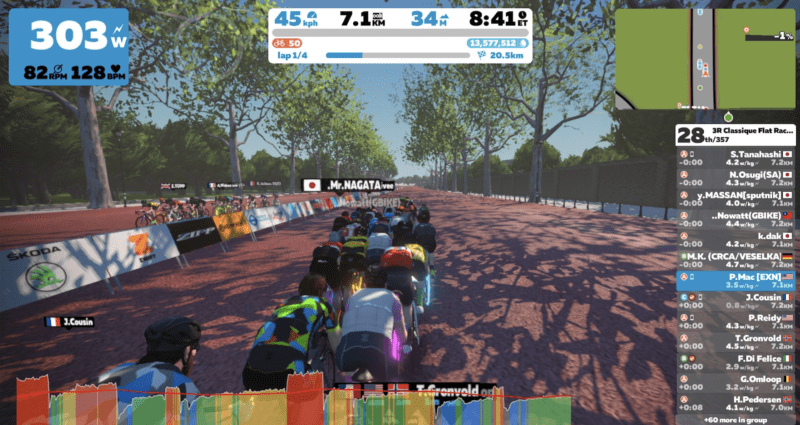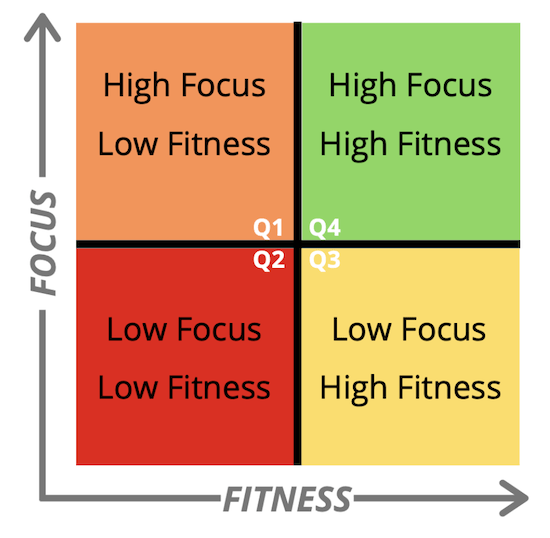
The surge of virtual online challenges threatens to disrupt the overall athletic progression required to be a successful endurance athlete. Real world races already have an existing hierarchy and precedence for each type of athlete. Digital challenges are the new wild West. From the Ironman Virtual Club to the Quarantine Backyard Ultra to virtual Tour events on Zwift, the question every athlete needs to ask themselves is “if they build it, should I compete?
The First Problem: Unlimited Races
A new event is only a few clicks away, and it’s clear that a type of land grab is underway between race organizers, training platforms, “celebrity” athletes and The original gangsters (the companies that have been doing it for years).
The Solution: Start with your Focus and the Event Timing
From a focus perspective, you can begin the conversation by looking back at what you set out to achieve this year as an endurance athlete. For example, if you had picked a 70.3 Triathlon as your target event, then doing a sprint or Olympic triathlon along the way simply makes sense. In fact, you probably had one or two of those schedules in the real world anyway. This is a great example of what “fits.”
If you were training for the same type of race, but instead were interested in completing the 4 miles every four hours challenge as promoted by David Goggins, you would likely be stretching your capacity. Training for a 13.1 mile race is very different then running 48 miles in 48 hours.
The next element to consider his timing. If that target race of yours was in August, then you’re serious training would’ve started in May. Even though you have the mindset of a long distance traffic, there’s a period of time every year dedicated to building your fitness to get you ready. Simply dropping a new event within the next two weeks of that type of distance will be too much for your sister. After all, he would charge the progression to a real event and are now looking at competing at the same intensity within just two weeks. There’s no physiological way for you to ramp up your fitness quickly enough to compete at the same level you intended.
In reality the time in question is more one about Fitness. The more time you have, the more fitness you can build. There’s some athletes who have a generally high level of fitness for a broad period of time. These are roughly 5% of the endurance athlete population because they have the physiology to sustain it and the lifestyle to create it. Unless you fall in that particular category, your fitness is likely increasing at this time of year like all the other years before this one. So we need a decision making matrix to understand what is the best way forward with regards to this event given your athletic focus and your current fitness.

As you can see there are two axes in the matrix. The vertical one is focus, specifically the fit of the virtual event to watch would plan to do this season. The horizontal one is Fitness, where are you now at this decision making point from a Fitness perspective?
The vast majority of athletes are currently in Quadrant One. Events to fit their focus but they don’t have the fitness to actually compete in these events. Depending on the specifics of the event and your current level of fitness it could take anywhere from 4 to 8 weeks for you to get ready. You do have the option to reduce your expectations relative to the event, but that may not be something you’re interested in.
Athletes in Quadrant Two should just keep clicking and look for the next event. There is no upside to participating here. The good news is, you won’t likely have to wait long for someone to come up with an event that fits any of the other quadrants for you.
Athletes in Quadrant Three, also known as the “fun” quadrant, have the option of competing simply because they bring salad Fitness to the table. Even if the event doesn’t actually fit their current focus is possible it could play into a longer-term benefit for them. The only cost associated for a quarter and three athletes is related to time and perhaps the cost of the event if there is any. Outside of a short taper. And taking care of any logistical considerations, you should be ready to go.
Athletes in Quadrant Four are ready to rock. Not only does the event fit their overall focus for the season, but they have the fitness to actually do it. It’s this unique space, a sweet spot, but we are looking for. If you are in this quadrant and have the opportunity to enter an event by all means you should go for it.
The Second Problem: Random Events
As the saying goes, anything is possible — but that doesn’t mean you have to do it. From running to cycling to crossfit workouts and more, there are probably more challenges available right now than memes about posting the fourth picture from your camera roll. And both are exhausting. A large part of being an endurance athlete is having fun, and that includes doing fun stuff with your fitness. To put it another way, it’s not what you do that matters, it’s how you do it.
The Solution: Rig the Game So You Win.
Let’s assume that you’re going to compete in the event with a safe amount of fitness but without the specific focus that fits your year. This is the most likely scenario as the priorities of these virtual event directors are significantly different than those that you have as an athlete. The best way to move forward here is to make sure what about you participate in, that you will end up winning over the long-term.
How is this possible do you ask? You can frame the answer in the short- or long-term.
Short-Term Gains = Motivation & Mental Health
Many athletes are stuck in a position where they change their schedule has really impacted their motivation. As a coach, this is a high priority problem for me to solve because even small scale disruptions in training can greatly affect the long-term projections I have for athletic development. Since I plan by seasons, there’s a great deal of assumptions made with regards to the work each athlete will complete in route to their event. When you remove the event, all of the plant work comes into question. This is where the shorter events can be leveraged to boost motivation and athlete engagement.
In this scenario picking in event that fits the general focus of the athlete and becomes close to their current level of fitness is important. If you need to reach beyond the current level of fitness and working with the athlete to reduce expectations becomes important. This situation would dictate more of a “complete” focus than a “compete” focus. Done right, you could easily find several short term events that would match different incremental parts of an athlete season. Just as importantly, it will give the athlete a significantly greater amount of control over the current situation then they are experiencing right now.
Long-Term Gains = Sustainable Fitness
Well the great deal of it starts with your desired outcome as an athlete. For example, if you want to be a successful long course triathlete there are certain criteria you need to hit in terms of fitness for the bike and the run. Developing those simultaneously within the context of each season is incredibly hard. That’s what makes the current situation into a bit of an opportunity for you to explore a single sport fitness and use these events to your advantage.
Developmentally we recommend that most athletes improve the strength on the bike first and then eventually move over to the run. This is simply because and aggressive run focus can be detrimental to athletes who are not careful. But in the context of a time when there are no other immediate events or demands for cycling volume on your schedule, a run focus could make sense.
As an example, participating in a Last Man Standing type of event like the Backyard Ultra or in a time-fenced event such as the Goggins “4 miles every 4 hours for 48 hours” event, there is a significant amount of running that takes place but it’s distributed in a safe manner. You could easily reduce your run training for the week to prepare for this event and then pace yourself in order to complete it safely. Speed is not a factor here, consistency and durability are. And regardless of how much of the event you complete, you still have one in terms of adding a solid block of run training into your schedule.
How to Adapt Your Training for a Virtual Race
In the extremely likely event that you will be unable to resist the urge to compete in a virtual challenge, here are some steps you can take to make sure you enjoy the experience.
Set Expectations
First and foremost make sure that you’re very clear about what it is you’re trying to achieve. Are you just going into the event for fun? Are you going into it to compete against your friends? Are you trying to set a personal best at a particular distance? Or are you just trying to shake off the cobwebs from a tough winter? Whatever the reason, knowing your intent helps you set realistic expectations for the day.
Higher Goals = More Planning
Remember that the higher your goals, the more work will be required to make sure that everything is in place. For example, if you just want to finish then start when you want, race how you want to, enjoy the whole time. On the other end of the spectrum if you’re trying to set a personal best, everything has to be just right. Given that this could be your first ever “virtual race” it’s asking a long for everything to go your way. So you’ll need to be completely prepared. Ideally you will have a few events under your belt so that you will have worked out all the kinks before you hit the start button.
What is Your Key Workout (Rehearsal)
Otherwise known as a race rehearsal, this can work out is your chance to test your target fitness for the day and dial in your expectations of equipment, nutrition and data. It’s all well and good to have a time goal, but some folks will base it off of previous years performances. Or performances from the open road when this race will be indoors. Doing a test workout all are you to calibrate your expectations around what is required to achieve your goal. It might even need you to revise your original target. Either way knowledge is power and this is the fastest and most direct way to get it. Read on to the next section for some ideas.
Choosing the Right Course
Virtual challenges put you in control. You are, for all intents and purposes, your own race director. There are pros and cons to this. One of the most challenging parts will be choosing the right course for you for this event. Some athletes will choose to compete indoors using digital platforms. Others will head outside and test themselves against the open road in the conditions. Regardless of which option you choose, you want to have a distinct route in mind. The faster you want to go, the flatter and more direct the course should be. If you’re just in it for fun, feel free to be creative! Whatever course you choose, make sure it’s (1) safe and (2) the proper distance!
Testing Your Set Up
Once you’ve committed to the race and picture course, it’s time to make sure that your setup is ready to go. For some of you this could be the first opportunity for you to head outside and could result in some trouble if your equipment is in need of attention. Others of you may be indoors for the first time I need to make sure all of the sensors and trackers are working properly. The only thing worse than not finishing a race is not having any data for the race you did finish!! You should use the time leading up to the event to test all of your technology and make sure everything is functional. The more familiar you are with the set up the more you can focus on being your best in the event.
Data Tracking & Submission
This is mentioned above, but it bears repeating. You need to be 100% sure that all of your work is being captured on your device of choice. This data is your proof that you have done the work and are eligible to be included in the results. Each challenge will have it on the set of rules regarding where your data must live and how it should be presented. Be sure to read the instructions carefully to make sure you’re doing everything required to remain eligible. If you need technical support be sure to ask us on Facebook (www.facebook.com/endurancenation) and we’ll do our best.
Tapering Into a Virtual Race
The longer the race, the more you should taper. Tapering is a combination of rest and sharpening, and your weekly schedule should reflect this. All race guidance below includes a rest day before the “race” day. Moderate training includes short bursts of speed at goal race pace, in one or two disciplines. Light training is just that, easy to stay loose.
Run Virtual Race Taper Examples:
5k Race (sub 30 minutes)
- Key Workout: 2 x 1 mile @ 5k pace; done no closer than 5 days before.
- Taper: 3 Days as 2D light training, 1D day off.
10k Race (sub 60 minutes)
- Key Workout: 3 x 1 mile @ 10k pace; done no closer than 6 days before.
- Taper: 3 Days as 2D light training, 1D day off.
Half Marathon Race sub 2.25 hours)
- Key Workout: 10 mile long run (3mi @ Warm Up, 7mi Race Pace); done no closer than 7 days before.
- Taper: 5 Days as 2D moderate training, 2D light training, 1D day off.
Triathlon Virtual Race Taper Examples:
Sprint Triathlon (1 hour event) = 3 Days Taper & Prep
- Key Workout: Bike + 1 Mile Fast
- Taper: 3 Days as 2D light training, 1D day off.
Olympic Triathlon (2 hour event) = 4 Days Taper & Prep
- Key Workout: Bike + 2 Miles Fast
- Taper: 4 Days as 1D moderate training, 2D light training, 1D day off.
70.3 Triathlon (6 hour event) = 7 Days Taper & Prep
- Key Workout: Bike + 6 Miles Race Pace
- Taper: 7 Days as 1D off, 2D moderate training, 3D light training, 1 day off.
Have Questions?
Find us on the official Endurance Nation Facebook page and send us a message. We’ll do our best to help you out!



Leave a Reply